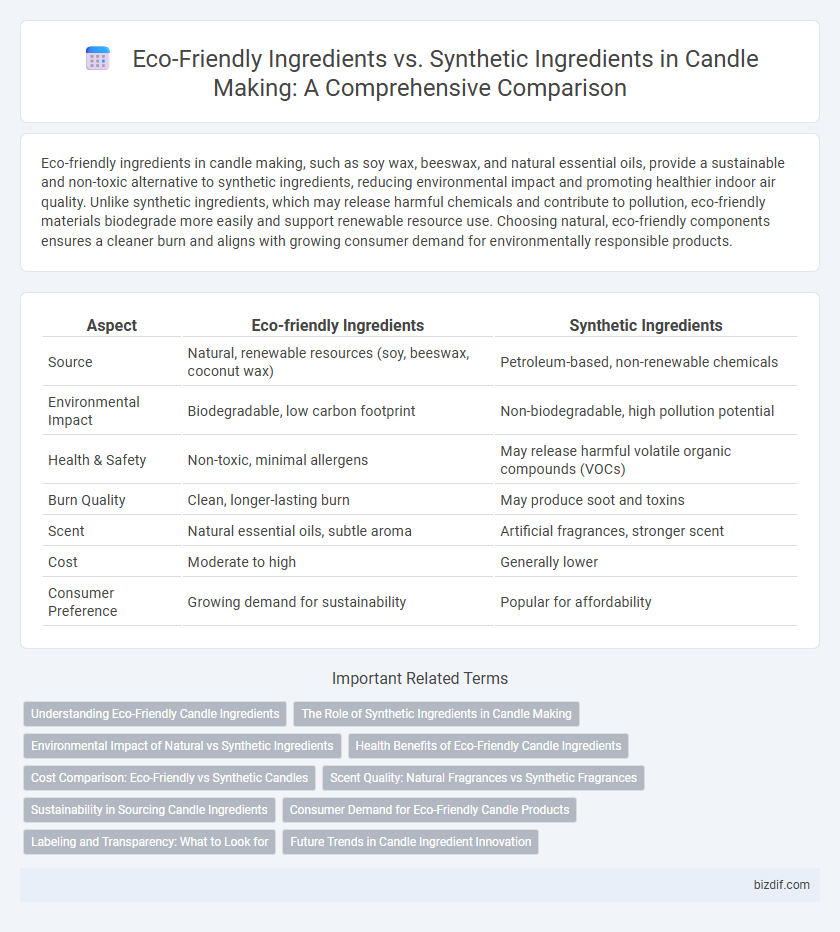Eco-friendly ingredients in candle making, such as soy wax, beeswax, and natural essential oils, provide a sustainable and non-toxic alternative to synthetic ingredients, reducing environmental impact and promoting healthier indoor air quality. Unlike synthetic ingredients, which may release harmful chemicals and contribute to pollution, eco-friendly materials biodegrade more easily and support renewable resource use. Choosing natural, eco-friendly components ensures a cleaner burn and aligns with growing consumer demand for environmentally responsible products.
Table of Comparison
| Aspect | Eco-friendly Ingredients | Synthetic Ingredients |
|---|---|---|
| Source | Natural, renewable resources (soy, beeswax, coconut wax) | Petroleum-based, non-renewable chemicals |
| Environmental Impact | Biodegradable, low carbon footprint | Non-biodegradable, high pollution potential |
| Health & Safety | Non-toxic, minimal allergens | May release harmful volatile organic compounds (VOCs) |
| Burn Quality | Clean, longer-lasting burn | May produce soot and toxins |
| Scent | Natural essential oils, subtle aroma | Artificial fragrances, stronger scent |
| Cost | Moderate to high | Generally lower |
| Consumer Preference | Growing demand for sustainability | Popular for affordability |
Understanding Eco-Friendly Candle Ingredients
Eco-friendly candle ingredients such as soy wax, beeswax, and natural essential oils offer sustainable alternatives to synthetic components, reducing environmental impact and promoting healthier indoor air quality. These natural materials are biodegradable, renewable, and free from harmful chemicals commonly found in paraffin wax and synthetic fragrances. Selecting eco-friendly ingredients supports eco-conscious consumers seeking clean-burning, non-toxic candles that align with green living values.
The Role of Synthetic Ingredients in Candle Making
Synthetic ingredients in candle making provide consistent fragrance release and vibrant colors, essential for creating diverse and long-lasting candle products. These ingredients often enhance burn performance and scent throw, allowing manufacturers to meet consumer demands for strong, uniform aromas. Despite environmental concerns, synthetic compounds remain cost-effective and versatile compared to eco-friendly alternatives.
Environmental Impact of Natural vs Synthetic Ingredients
Eco-friendly candle ingredients such as soy wax, beeswax, and natural essential oils significantly reduce environmental impact by being biodegradable and sustainably sourced. Synthetic ingredients, including paraffin wax and artificial fragrances, contribute to pollution through petroleum-based extraction and non-biodegradable chemical residues. Choosing natural components minimizes carbon footprint and supports ecological balance, enhancing overall sustainability in candle making.
Health Benefits of Eco-Friendly Candle Ingredients
Eco-friendly candle ingredients such as soy wax, beeswax, and natural essential oils release fewer toxins and volatile organic compounds (VOCs) compared to synthetic ingredients, reducing indoor air pollution and potential respiratory issues. These natural components promote a cleaner burn, minimizing allergens and irritants that can trigger asthma or allergies. Choosing eco-friendly materials supports safer, healthier environments for both candle makers and consumers.
Cost Comparison: Eco-Friendly vs Synthetic Candles
Eco-friendly candle ingredients, such as soy wax, beeswax, and natural essential oils, generally cost more upfront compared to synthetic paraffin wax and artificial fragrances due to sustainable sourcing and processing. However, eco-friendly candles often offer better burn quality and are biodegradable, providing long-term value despite higher initial expenses. Synthetic candles remain cheaper to mass-produce, making them a more affordable option for budget-conscious consumers but sacrificing environmental benefits.
Scent Quality: Natural Fragrances vs Synthetic Fragrances
Eco-friendly candle makers prioritize natural fragrances derived from essential oils, offering complex scent profiles that evolve subtly over time, unlike synthetic fragrances which often produce a sharp, overpowering aroma. Natural ingredients not only enhance the scent quality but also reduce exposure to harmful chemicals, supporting a healthier indoor air environment. Synthetic fragrances, while more cost-effective and consistent, lack the depth and authenticity found in eco-friendly aromatics, influencing consumer preference toward sustainable candle options.
Sustainability in Sourcing Candle Ingredients
Eco-friendly candle ingredients such as soy wax, beeswax, and essential oils offer sustainable sourcing by reducing environmental impact and supporting renewable agriculture. Synthetic ingredients often rely on petrochemicals, contributing to pollution and resource depletion, undermining sustainability efforts. Prioritizing natural, biodegradable components in candle making enhances eco-conscious production and aligns with responsible environmental stewardship.
Consumer Demand for Eco-Friendly Candle Products
Consumer demand for eco-friendly candle products is rapidly increasing due to growing awareness of environmental impact and health concerns associated with synthetic ingredients like paraffin wax and artificial fragrances. Natural, renewable materials such as soy wax, beeswax, and essential oils are favored for their biodegradability and non-toxic properties, appealing to environmentally conscious buyers. Brands incorporating sustainable sourcing and transparent ingredient lists experience higher market engagement and loyalty among eco-conscious consumers.
Labeling and Transparency: What to Look for
Eco-friendly candle ingredients often include soy wax, beeswax, and essential oils, which are renewable and biodegradable, offering safer indoor air quality compared to synthetic alternatives like paraffin and chemical fragrances that may emit harmful toxins. When examining candle labels, prioritize those that explicitly state "100% natural," "phthalate-free," and provide detailed ingredient lists to ensure full transparency and environmental responsibility. Certifications such as USDA Organic, Fair Trade, or ECOCERT further validate the authenticity and eco-consciousness of the product, guiding consumers toward healthier, sustainable choices.
Future Trends in Candle Ingredient Innovation
Eco-friendly ingredients such as soy wax, beeswax, and natural essential oils are driving the future of candle ingredient innovation due to their sustainability and biodegradability. Synthetic ingredients, including paraffin wax and artificial fragrances, are increasingly scrutinized for environmental and health concerns, prompting a shift toward greener alternatives. Emerging trends prioritize plant-based materials, recyclable packaging, and toxin-free formulations to meet consumer demand for eco-conscious products.
Eco-friendly ingredients vs Synthetic ingredients Infographic

 bizdif.com
bizdif.com